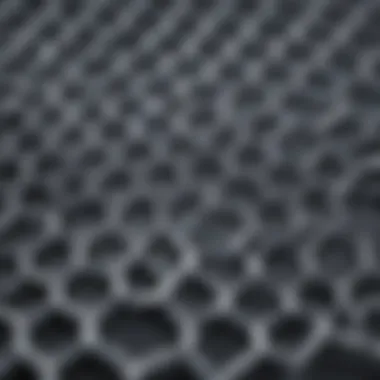Analyzing Graphene Production Cost Factors


Intro
Graphene is a single layer of carbon atoms arranged in a hexagonal lattice. This material has gained prominence due to its exceptional electrical, thermal, and mechanical properties. Understanding the cost factors associated with graphene production is essential for researchers and industrial practitioners alike. This examination reveals how cost influences the development and scalability of graphene applications, particularly in electronics, materials science, and other fields.
Production methods greatly dictate the price of graphene. Both chemical and mechanical synthesis approaches have specific costs related to materials, labor, and time. As researchers continue to identify more efficient methods, the economic implications expand, raising questions about future accessibility and industry integration. It becomes essential to explore these cost dynamics, which not only determine market viability but also shape future research trajectories.
Methodologies
Description of Research Techniques
Graphene production techniques typically fall into two categories: top-down and bottom-up methods. Top-down techniques, such as mechanical exfoliation and chemical vapor deposition, involve breaking down bulk materials into graphene. On the other hand, bottom-up techniques, like chemical reduction of graphene oxide, focus on assembling graphene from individual molecules or clusters. Each method brings distinct advantages, costs, and scalability potential.
- Chemical Vapor Deposition (CVD): Widely regarded for producing high-quality graphene, CVD involves heating a substrate in the presence of carbon-containing gases. The cost factors include gas sources, substrate prices, and equipment maintenance.
- Mechanical Exfoliation: Often seen in laboratory settings, this method uses adhesive tape to layer graphene onto substrates. The simplicity of the process can be attractive, but scalability is limited and production rates can be low.
- Liquid Phase Exfoliation: This technique involves dispersing graphite in a solvent, using sonication to produce graphene flakes. It allows for larger-scale production but can introduce impurities that may affect the material's properties.
Tools and Technologies Used
A variety of tools and technologies enhance the graphene production process. Key instruments include:
- Atomic Force Microscopes (AFM): Used for characterizing the surface topography and thickness of graphene sheets.
- Scanning Electron Microscopes (SEM): Essential for observing morphology and layer structure at high resolutions.
- Raman Spectroscopy: Important for assessing the quality and defects in graphene materials.
These technologies facilitate understanding production quality and efficiency, ultimately influencing the cost of graphene.
Discussion
Comparison with Previous Research
The advancements in graphene production techniques have led to significant shifts in cost-efficiency. Compared to earlier methods, modern approaches yield better quality at reduced costs. For instance, CVD has become a prominent method due to advancements in gas management and substrate technologies. Previous research points to high expenses in scale-up, which contemporary methods seek to resolve.
Theoretical Implications
Theoretical frameworks concerning graphene production costs show a direct relationship between synthesis methodology and market price. As researchers explore innovative production techniques, theories must be adapted to account for rapid changes in material science. This constant evolution highlights the need for ongoing research into both the cost implications and the practicality of scalability in the field.
Continuous advancements in graphene manufacturing promise to bridge gaps between theoretical potential and real-world application, steering future investments and research towards more sustainable practices.
Understanding the intricacies behind graphene's cost dynamics presents crucial insights for industry stakeholders. With a focus on innovative methodologies and practical cost analyses, this exploration enhances the prospects of integrating graphene into various industrial applications.
Intro
In the quest to harness graphene's potential, it is vital to dissect not just the prices associated with its production, but also the processes that influence these expenses. By analyzing various production methods, one can identify efficiencies and the kind of technology that might lower costs over time.
A consideration of economic implications is crucial. High production costs can deter entry into the market for companies and researchers. This, in turn, limits innovation and the practical applications that may benefit society. Understanding these costs can help policy-makers make informed decisions about funding and regulations related to graphene research.
In summary, grappling with the cost factors related to graphene production offers a comprehensive understanding of its commercial viability and paves the way for breakthroughs in technology that leverage its unique characteristics.
Defining Graphene
Graphene is a single layer of carbon atoms arranged in a two-dimensional honeycomb lattice. This arrangement imparts unique properties to graphene, such as its exceptional electrical conductivity, mechanical strength, and thermal conductivity. These characteristics arise from the nature of carbon atoms and their bonding.
Graphene is sometimes described as a building block for other carbon allotropes, such as graphite, carbon nanotubes, and fullerenes. Its structure is what makes it a fascinating subject in materials science. Current research is focusing on how graphene can be produced in a cost-effective way while maintaining its superior qualities, which makes it an important topic in both scientific and industrial realms.
Overview of Graphene Applications
Graphene's versatility opens avenues in numerous fields, offering transformative potential. The following list highlights key applications:
- Electronics: Its excellent conductivity makes graphene suitable for high-speed transistors and flexible electronic devices.
- Energy: Graphene can improve battery technology, making them lighter and capable of holding more charge. It is also being explored for supercapacitors.
- Sensors: Graphene's sensitivity to chemical changes allows it to be used in advanced sensors for various applications, from medical diagnostics to environmental monitoring.
- Composites: Adding graphene to materials can enhance their strength and lightness, impacting the automotive and aerospace industries.
- Biomedicine: Research is currently being conducted on using graphene in drug delivery systems and other biomedical applications due to its biocompatibility.


"Graphene is not only a material of the future; it has potential to change the landscape of multiple industries today."
Production Methods of Graphene
The methods used to produce graphene play a crucial role in determining its quality, accessibility, and overall cost. Each production technique brings specific advantages and hurdles, which must be understood by researchers and industry professionals alike. As the demand for graphene continues to grow in sectors such as electronics, energy, and materials science, optimizing production methods is vital to enhance both the material's quality and the economic feasibility of large-scale applications. The effectiveness of each production method directly influences the supply chain, manufacturing costs, and, consequently, the market price.
Mechanical Exfoliation
Mechanical exfoliation involves the physical separation of graphene sheets from bulk graphite. This method typically utilizes adhesive tape or other tools to peel off thin layers of graphene. Although this technique can produce high-quality graphene, it is often limited by scalability. It is labor-intensive and yields a small amount of material, which is not suitable for mass production.
Despite these limitations, mechanical exfoliation is often used in research settings due to its straightforward approach and ability to generate extremely pure graphene.
Chemical Vapor Deposition
Chemical vapor deposition (CVD) is a widely employed technique for producing large-area graphene films. This method involves the deposition of carbon atoms on a substrate from a gaseous phase. CVD can produce high-quality graphene suitable for various applications, including electronic devices and sensors. However, the complexity of the equipment and the high energy requirements can drive up production costs. Additionally, ensuring uniformity across the product can be challenging, necessitating tight control over the process conditions.
CVD remains a preferred method in commercial scenarios where quality is non-negotiable but often comes at a higher price.
Chemical Reduction of Graphene Oxide
The chemical reduction of graphene oxide is pivotal for obtaining graphene from its oxide form. Starting with graphene oxide, which is more easily synthesized from graphite, this method involves reducing the oxide to remove oxygen groups, enhancing electrical conductivity. This process can be carried out with various reducing agents, affecting the final properties of graphene.
While this method is potentially cost-effective and scalable, achieved graphene quality varies significantly. Impurities from the reduction process can hinder performance in certain applications. Therefore, balancing cost and quality remains a critical consideration for manufacturers.
Liquid Phase Exfoliation
Liquid phase exfoliation is another scalable method often used for graphene production. In this technique, graphite is dispersed in a solvent and mechanically stirred, leading to the formation of graphene sheets. This method allows for the production of larger quantities of graphene while maintaining relatively good quality.
However, the choice of solvent and processing parameters can significantly affect the quality and yield. Furthermore, subsequent processing stages may still be necessary to achieve desired material characteristics, which can complicate the production workflow.
In summary, the choice of production method profoundly influences the cost factors associated with graphene manufacturing. Each approach has its strengths and weaknesses, dictating the economics of large-scale production and realistic pricing on the market.
Factors Influencing Graphene Cost
Understanding the variables that impact the price of graphene is essential in evaluating its viability in various applications. These factors not only shape the production costs but also influence market dynamics. By identifying and analyzing these aspects, stakeholders in research, industry, and policy can make informed decisions about graphene's future. It entails considering the quality of raw materials, the energy used in production, labor costs, and the necessitated research and development. All these elements collectively determine the financial landscape for graphene production and its accessibility for widespread use.
Raw Material Costs
The cost associated with raw materials is a crucial determinant in the price of graphene production. High-quality materials are often needed to produce graphene efficiently. Natural graphite is a common source, but it can be costly due to extraction and processing requirements. The geographical location of raw material sources also affects transportation expenses, further impacting the overall cost.
Many producers are looking for alternative materials, such as graphite from recycling processes or other carbon sources. However, these options can present their own challenges related to cost and sustainability. Understanding the material supply chain is vital for producers aiming to manage costs efficiently while maintaining quality.
Energy Consumption in Manufacturing
Energy usage is another significant factor that influences production costs. Different methods of graphene synthesis require varying amounts of energy. For example, Chemical Vapor Deposition (CVD) can consume substantial energy, which translates into higher operational costs. On the other hand, methods like mechanical exfoliation might use less energy, making them more economically feasible for specific applications.
In addition to direct energy costs, the environmental impact of energy consumption needs consideration. More eco-friendly methods are becoming important due to increasing regulations on carbon emissions. Thus, integrating energy-efficient practices can potentially reduce costs and align with global sustainability goals.
Labor and Operational Expenses
Labor costs play a vital role in the overall cost structure of graphene production. The production of graphene involves skilled workers who understand complex manufacturing processes. As such, wages in this sector can be higher than in other industries, driving up expenses. Furthermore, operational costs, including maintenance of equipment and facility costs, add another layer of financial implications.
Effective management of labor and operational resources is crucial in keeping costs competitive. Automation technologies are emerging as a solution to minimize labor costs while maintaining production quality. However, initial investment in such technologies can be significant, presenting a dilemma for manufacturers.
Research and Development Costs
Investment in research and development is paramount to advancing graphene production techniques. Innovative methods can lead to cost reductions over time as technologies mature. However, R&D requires substantial funding and resources. The balance between investing in R&D and maintaining profitability is delicate and influences long-term sustainability in the market.


As the field of graphene production evolves, ongoing research will be necessary to exploit new technologies and improve existing methods. Establishing collaborations between academia and industry can be beneficial in sharing costs and resources for effective innovation.
Understanding the nuances of cost factors is essential for navigating the graphene market and fostering sustainable growth.
Market Dynamics of Graphene
Understanding the market dynamics surrounding graphene is crucial for comprehending its overall cost factors. This section examines how various elements influence both its price and availability. Market dynamics encapsulate elements such as supply chains, pricing strategies, and consumer demand that fluctuate based on the material's perceived value and advancements in technology. The interplay of these factors can significantly affect production costs and the accessibility of graphene across various sectors.
Current Market Trends
The landscape of graphene production is shaped by several prominent trends. First, there has been a notable increase in research funding dedicated to graphene technologies, driven by its potential applications in electronics, energy storage, and biomedicine. Industry leaders are investing in scaling up production methods, while academic institutions focus on fundamental research to unlock new properties of graphene.
Additionally, the price of graphene has been in flux. As production methods evolve, costs may decrease, allowing wider usage in consumer products. Competition among manufacturers is also rising, contributing to more aggressive pricing strategies. As a result, the market is witnessing a diversification of graphene applications, with industries seeking to integrate this material into existing products, thus expanding demand and potentially stabilizing prices across the board.
Supply and Demand Factors
The relationship between supply and demand significantly impacts the cost of graphene. High-quality graphene remains limited due to the complexity of production processes. As various industries seek to incorporate graphene into their offerings—be it in coatings, batteries, or composite materials—a mismatch between supply capabilities and rising demand can lead to higher prices.
Several factors are at play here:
- Production Capacity: Manufacturing rates need to match demand growth. Currently, many processes are in development and scaling operations takes time.
- Material Sources: The availability of raw materials for graphene production can be inconsistent. Variations can lead to supply chain tensions.
- Market Entry of New Players: Increasing interest from startups and established companies creates competitive pressure to supply high-quality graphene, affecting market pricing.
Competitive Landscape
The competitive landscape of graphene production is marked by both established companies and emerging startups. Notable manufacturers like Graphenea, Angstron Materials, and XG Sciences, play a dominant role in shaping market strategies, often leading to innovation in production methods and focused application development.
Smaller companies frequently specialize in niche applications of graphene, contributing to a diverse and expanding market.
- Innovative Approaches: Competition drives companies to adopt innovative methods for lowering production costs while ensuring quality.
- Partnerships and Collaborations: Many firms engage in partnerships to enhance their technological capabilities. This accelerates development and may lead to cost reductions long-term.
- Global Competition: Companies across different regions are vying for market share, especially in areas with substantial technological advancements like the EU and Asia.
"The world of graphene is shifting. Companies not only compete on price but also on innovation in applications and process efficiencies."
Understanding these market dynamics is vital to grasp the intricate cost factors of graphene production. As companies navigate the challenges and opportunities presented, the industry is primed for significant evolution.
Challenges in Graphene Production
The production of graphene, despite its potential and uniqueness, does not come without substantial challenges. Understanding these challenges is imperative for grasping the complexities of graphene manufacturing. This section highlights the key issues, including scalability, quality control, and environmental impacts, which play a crucial role in determining the feasibility and market price of graphene products. Recognizing and addressing these issues is essential for evolving the industry and making graphene more accessible.
Scalability Concerns
One of the primary challenges in graphene production is its scalability. While small-scale production may yield satisfactory quality, transferring these methodologies to large-scale operations often leads to significant obstacles. This difficulty arises mainly from the intricacies involved in maintaining quality while increasing output.
- Manufacturing Techniques: Different production methods, such as chemical vapor deposition and mechanical exfoliation, pose varying levels of scalability. For instance, while mechanical exfoliation is effective in producing high-quality graphene, its process is not practical for large quantities.
- Economic Viability: As the demand for graphene rises, so does the necessity to produce it in large amounts efficiently. The scaling up of production processes can lead to increased costs, making the material less appealing for commercial use.
Quality Control Issues
Quality control is a significant concern in the production of graphene that cannot be overlooked. Consistency in the quality of graphene is essential for its performance in applications, such as electronics and materials science.
- Characterization Standards: The lack of established standards for characterizing graphene properties can lead to variances in quality among batches. This inconsistency poses a risk to consumers in industries that rely on specific material properties.
- Defects and Contaminants: During production, the potential for introducing defects and contaminants increases, which directly affects the material's conductivity and overall performance. Ongoing efforts to establish reliable testing and quality assurance protocols are essential to mitigate these issues.
Environmental Impact Considerations
The environmental implications of graphene production present yet another challenge. As the industry grows, it is important to address the ecological footprint associated with manufacturing processes.
- Resource Consumption: The extraction of raw materials and energy intensive manufacturing processes contribute to a broader environmental concern. This calls for the need to optimize production methods to minimize resource depletion and energy use.
- Waste Management: Some production methods generate considerable waste. Developing efficient waste management solutions and exploring recycling options will be critical in reducing the industry's ecological impact.


"Addressing the environmental implications of graphene production will be paramount for its sustainable integration into various applications."
Future Prospects for Graphene Cost
Understanding the future prospects for graphene cost is critical for stakeholders invested in its production. This subject influences not only researchers but also manufacturers and policymakers. As advancements in the efficiency of production methods occur, there is an expectation for a reduction in costs. This section explores the elements central to graphene's cost future, emphasizing emerging technologies, regulatory influences, and the potential for cost reduction.
Emerging Technologies
Technological advancement plays a pivotal role in the potential reduction of graphene production costs. Various innovations are being researched and implemented to enhance synthesis efficiency and scalability. For instance, researchers are focusing on new techniques such as plasma-enhanced chemical vapor deposition (PECVD) and innovations in liquid phase exfoliation. These novel approaches may lower energy consumption and improve quality, thereby impacting costs positively.
- Plasma-Enhanced Chemical Vapor Deposition (PECVD)
- Liquid Phase Exfoliation Enhancements
- Offers flexibility in substrate choice.
- Provides better control over graphene layers.
- Potential for mass production at lower costs.
- Helps produce high-quality graphene sheets.
These technologies highlight a shift towards more sustainable practices. As the industry adapts, the comprehensive understanding of these innovations could lead to a more competitive graphene market.
Policy and Regulatory Influences
Regulations and policies have significant implications for the graphene sector. Governments around the world are beginning to recognize graphene's potential as a game-changing material. Supportive policies may foster research funding and initiatives aimed at graphene production. Institutional backing could expedite innovations in production techniques.
- Investment in Research and Development
- Standardization and Certification
- Encourages collaboration between universities and industries.
- Mitigates financial risks associated with cutting-edge projects.
- Facilitates trade and market access.
- Promotes quality assurance, which can build consumer trust.
Through strategic policy initiatives, governments can construct an environment conducive to lowering production costs. Regulatory frameworks that encourage experimentation will be essential in realizing graphene's full economic potential.
Potential for Cost Reduction
The potential for cost reduction in graphene production is significant, as various factors converge to create a promising outlook. The integration of innovative technologies and supportive policies leads to a favorable environment for reducing expenses associated with raw materials, labor, and energy consumption.
- Reducing raw material costs through better sourcing methods or recycling initiatives
- Streamlining processes to require less energy
- Enhancing labor efficiency through automation and training programs
"As advancements continue, the cost of graphene may approach that of traditional materials, reshaping numerous industries."
Graphene's ability to become economically viable depends on a collective effort from technology developers, policymakers, and market stakeholders. As these components align, the prospects for affordable graphene usage become increasingly achievable.
Overall, the future looks promising for graphene production costs. Emerging technologies, favorable policies, and ongoing innovation hold the key to unlocking its broader commercial applications.
Ending
Summary of Key Findings
The key findings presented throughout the article emphasize the multifaceted nature of graphene production costs. Several elements influence these costs, and among these are:
- Production methods: Different synthesis techniques, such as Mechanical Exfoliation and Chemical Vapor Deposition, have diverse economic implications. Some methods are cost-efficient but may compromise quality, while others ensure high standards at increased financial investment.
- Raw materials and energy costs: The price of precursor materials and energy consumption during manufacturing are critical factors. Fluctuating supply chains can significantly affect operational expenses.
- Labor and operational costs: Skilled workforce is necessary to maintain consistent quality and efficiency. Additionally, operational expenses can vary depending on the geographic location of production facilities.
- Research and development efforts: Continuous innovation drives the field forward. Investments in R&D play a major role in developing cost-effective methods for graphene synthesis.
The confluence of these aspects creates a dynamic landscape that is constantly shifting due to both market demands and technological advancements.
Final Thoughts on Graphene's Future
As we look ahead, the future of graphene production appears promising yet complex. As emerging technologies develop, the potential for cost reduction becomes more feasible. The ongoing research on alternative production methods can enhance quality while lowering costs, making graphene more accessible for industrial applications.
Moreover, regulatory influences will shape how the graphene market evolves. Government policies focused on sustainable practices can impact production methodologies and prioritize environmentally friendly approaches.
Understanding these dynamics positions stakeholders to make informed decisions. The growing interest in graphene holds potential not only for the material’s affordability but also its broader applications in technology, energy, and materials science, ultimately playing a crucial role in advancing innovation.
"With the right investment and focus, graphene can shift from being a theoretical marvel to a practical component of everyday technology."
\nIn conclusion, recognizing the cost factors tied to graphene production is essential in navigating its future landscape. Each component contributes uniquely to the overall equation, and an integrated approach will be crucial for maximizing its potential.



